
Euoplocephalus is a genus of very large, herbivorous ankylosaurid dinosaurs, living during the Late Cretaceous of Canada. It has only one named species, Euoplocephalus tutus.

Animantarx is a genus of nodosaurid ankylosaurian dinosaur from the Early and Late Cretaceous of western North America. Like other nodosaurs, it would have been a slow-moving quadrupedal herbivore covered in heavy armor scutes, but without a tail club. The skull measures approximately 25 cm in length, suggesting the animal as a whole was no more than 3 meters long.

Edmontonia is a genus of panoplosaurin nodosaurid dinosaur from the Late Cretaceous Period. It is part of the Nodosauridae, a family within Ankylosauria. It is named after the Edmonton Formation, the unit of rock where it was found.

Struthiosaurus is a genus of nodosaurid dinosaurs, from the Late Cretaceous period (Santonian-Maastrichtian) of Austria, Romania, France and Hungary in Europe. It was a small dinosaur, measuring 2–3 m (6.6–9.8 ft) in length and weighing 300–400 kg (660–880 lb).

Aletopelta is a monospecific genus of basal ankylosaurid dinosaur from Southern California that lived during the Late Cretaceous in what is now the Point Loma Formation. The type and only species, Aletopelta coombsi, is known from a partial skeleton preserving osteoderms. It was originally described in 1996 by W. P. Coombs, Jr. and T.A. Deméré before being named in 2001 by Tracy Ford and James Kirkland. Aletopelta has an estimated size of 5 metres and weight of 2 tonnes. The holotype formed a miniature reef and was scavenged upon by invertebrates and sharks.
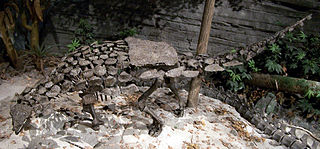
Nodosauridae is a family of ankylosaurian dinosaurs, from the Late Jurassic to the Late Cretaceous period in what is now North America, South America, Europe, and Asia.
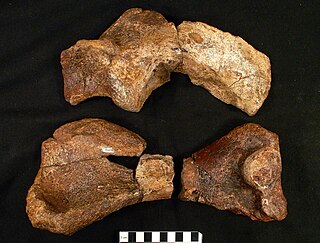
Texasetes is a genus of ankylosaurian dinosaurs from the late Lower Cretaceous of North America. This poorly known genus has been recovered from the Paw Paw Formation near Haslet, Tarrant County, Texas, which has also produced the nodosaurid ankylosaur Pawpawsaurus.
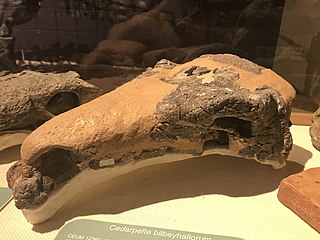
Cedarpelta is an extinct genus of basal ankylosaurid dinosaur from Utah that lived during the Late Cretaceous period in what is now the Mussentuchit Member of the Cedar Mountain Formation. The type and only species, Cedarpelta bilbeyhallorum, is known from multiple specimens including partial skulls and postcranial material. It was named in 2001 by Kenneth Carpenter, James Kirkland, Don Burge, and John Bird. Cedarpelta has an estimated length of 7 metres and weight of 5 tonnes (11,023 lbs). The skull of Cedarpelta lacks extensive cranial ornamentation and is one of the only known ankylosaurs with individual skull bones that are not completely fused together.

Denversaurus is a genus of panoplosaurin nodosaurid dinosaur from the late Maastrichtian of Late Cretaceous Western North America. Although at one point treated as a junior synonym of Edmontonia by some taxonomists, current research indicates that it is its own distinct nodosaurid genus.
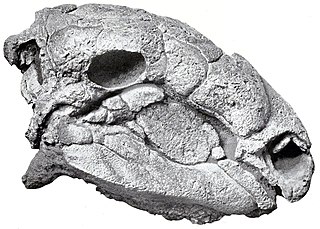
Panoplosaurus is a genus of armoured dinosaur from the Late Cretaceous of Alberta, Canada. Few specimens of the genus are known, all from the middle Campanian of the Dinosaur Park Formation, roughly 76 to 75 million years ago. It was first discovered in 1917, and named in 1919 by Lawrence Lambe, named for its extensive armour, meaning "well-armoured lizard". Panoplosaurus has at times been considered the proper name for material otherwise referred to as Edmontonia, complicating its phylogenetic and ecological interpretations, at one point being considered to have existed across Alberta, New Mexico and Texas, with specimens in institutions from Canada and the United States. The skull and skeleton of Panoplosaurus are similar to its relatives, but have a few significant differences, such as the lumpy form of the skull osteoderms, a completely fused shoulder blade, and regularly shaped plates on its neck and body lacking prominent spines. It was a quadrupedal animal, roughly 5 m (16 ft) long and 1,600 kg (3,500 lb) in weight. The skull has a short snout, with a very domed surface, and bony plates directly covering the cheek. The neck had circular groups of plates arranged around the top surface, both the forelimb and hindlimb were about the same length, and the hand may have only included three fingers. Almost the entire surface of the body was covered in plates, osteoderms and scutes of varying sizes, ranging from large elements along the skull and neck, to smaller, round bones underneath the chin and body, to small ossicles that filled in the spaces between other, larger osteoderms.
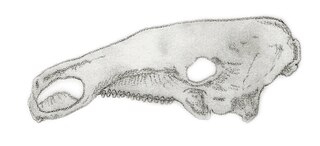
Silvisaurus, from the Latin silva "woodland" and Greek sauros "lizard", is a nodosaurid ankylosaur from the Early to Late Cretaceous period.
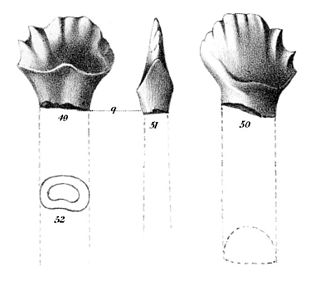
Palaeoscincus is a dubious genus of ankylosaurian dinosaur based on teeth from the mid-late Campanian-age Upper Cretaceous Judith River Formation of Montana. Like several other dinosaur genera named by Joseph Leidy, it is an historically important genus with a convoluted taxonomy that has been all but abandoned by modern dinosaur paleontologists. Because of its wide use in the early 20th century, it was somewhat well known to the general public, often through illustrations of an animal with the armor of Edmontonia and the tail club of an ankylosaurid.

Priconodon is an extinct genus of dinosaur, known from its large teeth. Its remains have been found in the Aptian-Albian age Lower Cretaceous Arundel Formation of Muirkirk, Prince George's County, Maryland, USA and the Potomac Group, also located in Maryland.
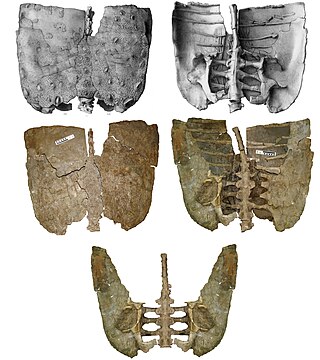
Polacanthinae is a subfamily of ankylosaurs, most often nodosaurids, from the Late Jurassic through Early Cretaceous of Europe and potentially North America and Asia. The group is defined as the largest clade closer to Polacanthus foxii than Nodosaurus textilis or Ankylosaurus magniventris, as long as that group nests within either Nodosauridae or Ankylosauridae. If Polacanthus, and by extent Polacanthinae, falls outside either family-level clade, then the -inae suffix would be inappropriate, and the proper name for the group would be the informally defined Polacanthidae.
The Paw Paw Formation is a geological formation in Texas whose strata date back to the late Albian stage of the Early Cretaceous. Dinosaur remains are among the fossils that have been recovered from the formation.
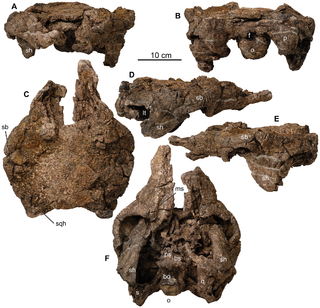
Europelta is a monospecific genus of nodosaurid dinosaur from Spain that lived during the Early Cretaceous in what is now the lower Escucha Formation of the Teruel Province. The type and only species, Europelta carbonensis, is known from two associated partial skeletons, and represents the most complete ankylosaur known from Europe. Europelta was named in 2013 by James I. Kirkland and colleagues. Europelta has an estimated length of 5 metres and weight of 1.3 tonnes, making it the largest member of the clade Struthiosaurini.

This timeline of ankylosaur research is a chronological listing of events in the history of paleontology focused on the ankylosaurs, quadrupedal herbivorous dinosaurs who were protected by a covering bony plates and spikes and sometimes by a clubbed tail. Although formally trained scientists did not begin documenting ankylosaur fossils until the early 19th century, Native Americans had a long history of contact with these remains, which were generally interpreted through a mythological lens. The Delaware people have stories about smoking the bones of ancient monsters in a magic ritual to have wishes granted and ankylosaur fossils are among the local fossils that may have been used like this. The Native Americans of the modern southwestern United States tell stories about an armored monster named Yeitso that may have been influenced by local ankylosaur fossils. Likewise, ankylosaur remains are among the dinosaur bones found along the Red Deer River of Alberta, Canada where the Piegan people believe that the Grandfather of the Buffalo once lived.

Kunbarrasaurus is an extinct genus of small herbivorous ankylosaurian dinosaur from the Cretaceous of Australia.

Panoplosaurini is a clade of nodosaurid ankylosaurs from the Cretaceous of North America and South America. The group is defined as the largest clade containing Panoplosaurus mirus, but not Nodosaurus textilis or Struthiosaurus austriacus, and was named in 2021 by Madzia and colleagues for the group found in many previous analyses, both morphological and phylogenetic. Panoplosaurini includes not only the Late Cretaceous Panoplosaurus, Denversaurus and Edmontonia, but also the mid Cretaceous Animantarx and Texasetes, as well as Patagopelta. However, in the study describing it, its authors only placed it as a nodosaurine outside Panoplosaurini. The approximately equivalent clade Panoplosaurinae, named in 1929 by Franz Nopcsa, but was not significantly used until Robert Bakker reused the name in 1988, alongside the new clades Edmontoniinae and Edmontoniidae, which were considered to unite Panoplosaurus, Denversaurus and Edmontonia to the exclusion of other ankylosaurs. As none of the clades were commonly used, or formally named following the PhyloCode, Madzia et al. named Panoplosaurini instead, as the group of taxa fell within the clade Nodosaurinae, and having the same -inae suffix on both parent and child taxon could be confusing in future. The 2018 phylogenetic analysis of Rivera-Sylva and colleagues was used as the primary reference for Panoplosaurini by Madzia et al., in addition to the supplemental analyses of Arbour et al. (2016), Brown et al. (2017), and Zheng et al. (2018).

Struthiosaurini is a clade of nodosaurid ankylosaurs from the Cretaceous of Europe and North America. The group is defined as the largest clade containing Struthiosaurus austriacus, but not Nodosaurus textilis or Panoplosaurus mirus, and was named in 2021 by Madzia and colleagues for the relatively stable group found in many previous analyses. Struthiosaurini includes not only the Late Cretaceous European Struthiosaurus, but also the Early Cretaceous European Europelta, the Late Cretaceous European Hungarosaurus, and Stegopelta and Pawpawsaurus from the mid Cretaceous of North America. The approximately equivalent clade Struthiosaurinae, named in 1923 by Franz Nopcsa was previously used to include European nodosaurids, but was never formally named following the PhyloCode, so Madzia et al. named Struthiosaurini instead, as the group of taxa fell within the clade Nodosaurinae, and having the same -inae suffix on both parent and child taxon could be confusing in future. The 2018 phylogenetic analysis of Rivera-Sylva and colleagues was used as the primary reference for Struthiosaurini by Madzia et al., in addition to the supplemental analyses of Arbour et al. (2016), Brown et al. (2017), and Zheng et al. (2018).




















